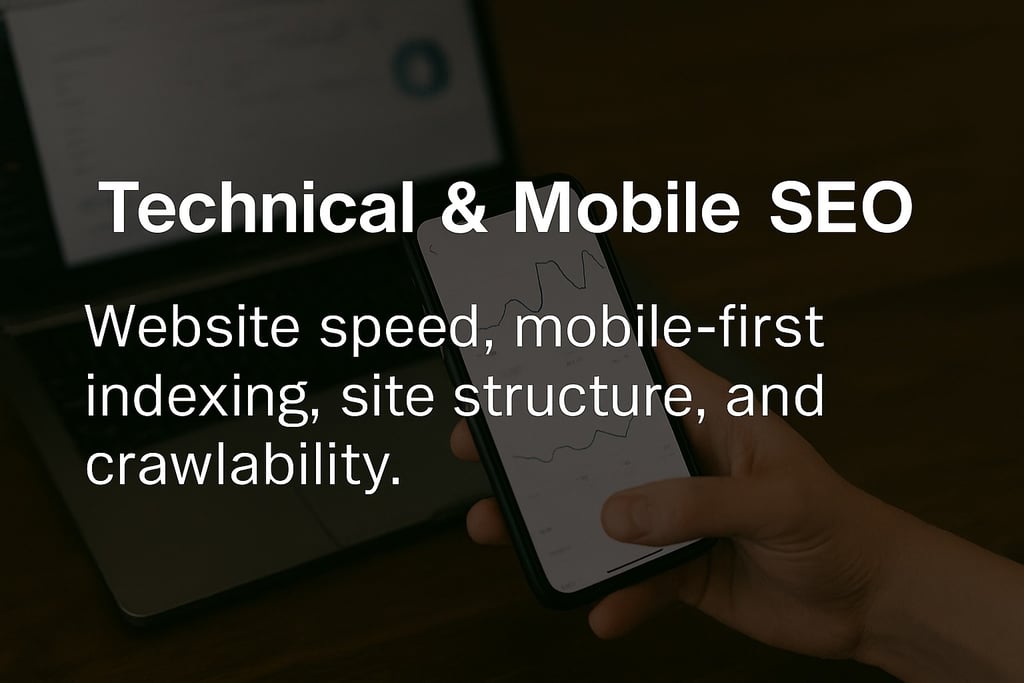GET STARTED - Book a free consultation -or- a $50 Website & SEO Audit report now!
Technical & Mobile SEO
Optimising Your Website for Speed, Mobile-First Indexing, and Crawlability
8/5/20253 min read


When it comes to ranking high on Google, great content and keywords are only part of the equation. If your website is slow, not mobile-friendly, or difficult for search engines to crawl, you’ll struggle to rank no matter how good your content is. This is where Technical SEO and Mobile SEO come in.
In this guide, we’ll explain the key aspects of technical SEO and mobile optimisation, including website speed, mobile-first indexing, site structure, and crawlability — all essential for Australian businesses aiming to improve their online visibility.
⸻
Why Technical SEO Matters
Technical SEO focuses on improving the backend elements of your website to help search engines understand, crawl, and index your site effectively. Without solid technical foundations, even the best on-page SEO won’t perform well.
If you’re a small business in Australia — whether you’re running an SEO consulting service in Toowoomba, an online shop in Brisbane, or a tradie website in South Burnett — technical SEO ensures your website loads fast, looks great on mobile, and is easy for Google to crawl.
⸻
Key Elements of Technical SEO for Small Businesses
1. Website Speed Optimisation – Faster Sites Rank Higher
Google has officially confirmed that page load speed is a ranking factor. A slow-loading site not only hurts your rankings but also increases bounce rates.
• Use Google PageSpeed Insights or GTmetrix to analyse your site speed.
• Optimise images (compress large files using TinyPNG or WebP format)
• Minify CSS, JavaScript, and HTML to reduce page size
• Leverage browser caching and enable lazy loading for images
Ideal load time: Under 3 seconds.
⸻
2. Mobile-First Indexing – Google Prioritises Mobile Experience
Since Google switched to mobile-first indexing, it evaluates your mobile site version first before the desktop version.
To ensure your site is mobile-optimised:
• Use a responsive design that adjusts to screen sizes
• Avoid using Flash or outdated elements that don’t work on mobile
• Ensure fonts are readable and buttons are easily clickable
• Check your site’s mobile usability in Google Search Console
If your mobile experience is poor, you’re losing rankings and potential customers.
⸻
3. Site Structure – Clear Navigation for Users and Search Engines
A well-structured website helps users find information quickly and makes it easier for search engines to crawl.
Best practices:
• Use a simple URL structure (e.g., www.yoursite.com/seo-services)
• Ensure your site hierarchy is logical with clear categories and subcategories
• Implement internal linking between related pages and blog posts
• Create and submit an XML sitemap to Google Search Console
Example: For an SEO agency in Brisbane, have pages like:
• /seo-services-brisbane
• /case-studies
• /contact-brisbane-office
⸻
4. Crawlability – Making Your Site Easy for Google to Understand
Google’s bots (crawlers) need to scan your website content to index it properly. To improve crawlability:
• Use robots.txt to guide search engine bots on which pages to crawl
• Avoid orphan pages (pages with no internal links pointing to them)
• Fix broken links (404 errors) regularly
• Ensure important content is no more than 3 clicks deep from the homepage
Regularly monitor crawl errors in Google Search Console and fix issues promptly.
⸻
Other Technical SEO Essentials
• HTTPS Security: Ensure your website uses SSL (HTTPS). Google gives ranking preference to secure websites.
• Canonical Tags: Prevent duplicate content issues by using canonical tags correctly.
• Structured Data (Schema Markup): Implement schema to enhance how your content appears in search results (rich snippets like star ratings, FAQs, etc.)
• Fix Redirect Chains: Avoid multiple redirects (301 -> 302 -> page), as they slow down load times.
⸻
Why Mobile SEO is Crucial for Australian Small Businesses
With over 60% of Australian users accessing websites on their smartphones, ignoring mobile SEO is no longer an option.
Key benefits of mobile optimisation:
• Better user experience = lower bounce rates
• Higher mobile rankings = more local traffic (think “near me” searches)
• Increases conversions through mobile-friendly CTAs and forms
⸻
Tools to Check Your Technical SEO Health
• Google Search Console – For crawl errors, mobile usability, and indexing issues
• Google PageSpeed Insights – For speed optimisation suggestions
• Screaming Frog SEO Spider – For in-depth technical audits
• GTmetrix – For page load analysis and recommendations
⸻
Conclusion
For Australian businesses aiming to dominate local search, mastering Technical SEO and Mobile SEO is a must. Website speed, mobile-first indexing, site structure, and crawlability are not just “nice-to-haves”—they’re essential ranking factors.
By fixing technical issues and ensuring your site delivers a smooth mobile experience, you’ll improve your Google rankings, attract more traffic, and keep visitors engaged.
Our Solutions for you
Expert SEO, website design, content creation and digital marketing services.
Serving South East Queensland including Darling Downs, Lockyer Valley, Toowoomba and Brisbane in person.
All work is done in Australia.
Connect
SEODevPro
+61 493258833
info@SEODevPro.com
© 2025. All rights reserved. OneMindSoftware ABN 33 129 219 462
Created using Hostinger Web Builder
Mon-Fri 9:00 - 17:00 AEST
Business Hours


Want a FREE Password Manager that requires:
- No login
- No memory
- No cloud
Check out https://calcpass.app
